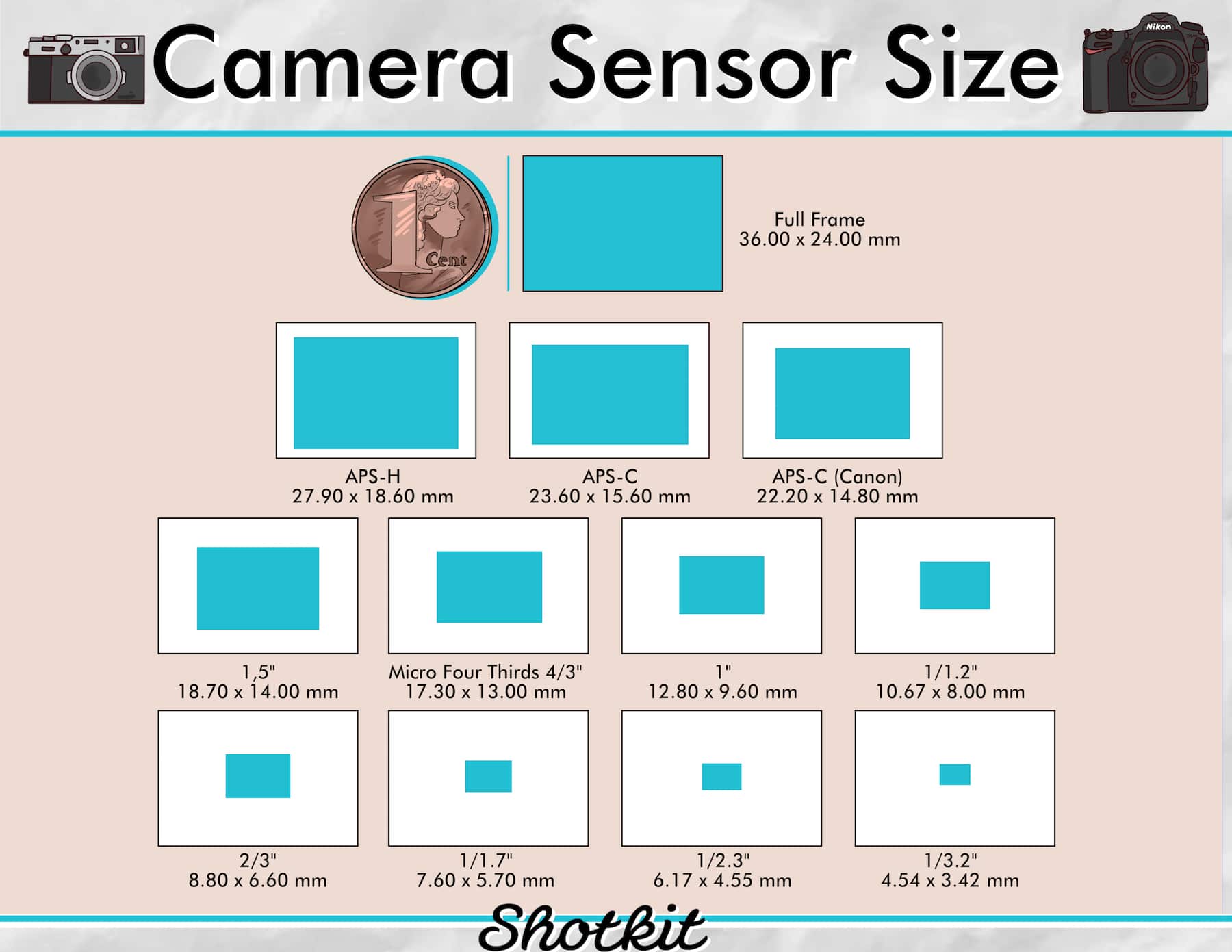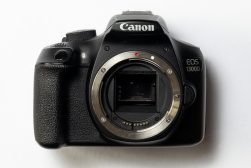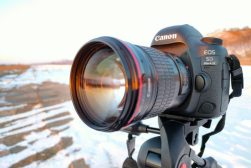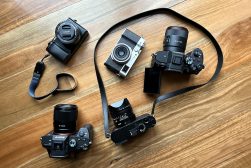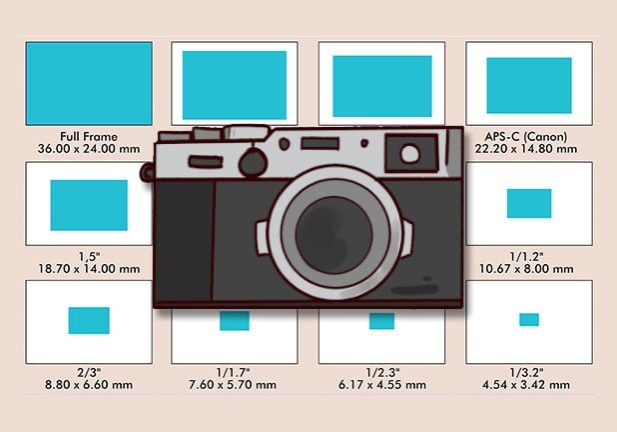
5 Types of Camera Sensor You Should Know
There's a lot of confusion surrounding the humble camera sensor. Find out why image sensor size is so important for photography, and what size is best for you.
Learn | Photography Guides | By Greg Cromie
If you’re thinking about buying a new camera, you might be wondering why the size of the camera sensor is important.
The simple answer is this: the image sensor’s size determines how much light can be captured to create an image.
However, there’s much more magic to these mysterious little pieces of electronic wizardry than just this!
In this guide, we’ll answer all the most common questions from photographers about camera sensors.
We’ve also included a handy camera sensor size chart, so you have a nice visual reference for comparison.
Let’s dive right in with a definition…
What is a Sensor in a Camera?
Let’s take a look at what a camera sensor is and how it works to record pixels – but first, a history lesson about film cameras.
When capturing images with a film camera, a small shutter opens, allowing light in for a fraction of a second. The light hits the film inside the camera, and it records light, colour, contrast and detail.
With digital cameras, the sensor is a device that sits inside the camera and works in much the same way – it replaced the film photography process.
But that begs the question, “How does a camera sensor work?”
A sensor houses millions of tiny light-sensitive receptors called photosites – counted as megapixels or millions of pixels.
When taking a photo with a smartphone, mirrorless or DSLR camera, a shutter opens to expose the sensor to the incoming light from the lens.
Photosites on the camera sensor capture the light like tiny buckets catching rain. The amount and size of the photosites determine the image quality and accurate recording of light, contrast, and colour.
A camera processor converts data from the photosites into an image and saves it to a memory card. The number of photosites on a sensor depends on several factors but can range from 16MP up to 102MP.
Plus, there’s a whole range of different image sensor sizes – we’ll get into that in just a minute.
It’s also important to remember that some cameras have low megapixels, but the individual photosites, or pixel size, are bigger.
The camera’s quality and sensor size determine an image’s resolution – the quality and pixel count of a photo.
How many types of camera sensors are there?
The most common sensor sizes of mirrorless and DSLR cameras are full-frame, APS-C and Micro Four Thirds.
Most compact cameras have smaller camera sensors to fit inside their pocketable bodies. However, with the ongoing development of smartphone cameras, a new generation of tiny sensors has risen.
Other common photography terms you’ll hear are CMOS sensors – Complementary Metal Oxide Semiconductor, and CCD sensors – Charge Coupled Device.
These refer to the function of converting light into an electrical signal within the sensor.
How Much Do You REALLY Know About Photography?! 🤔
Test your photography knowledge with this quick quiz!
See how much you really know about photography...

Camera Sensor Size Chart
One of the most important considerations is the camera sensor size – followed by the megapixel count – when camera shopping.
Some camera manufacturers only develop cameras with one sensor size. Others, especially well-known brands, create a range of sensor sizes to cover various photographers’ needs.
As you can see from the sensor size chart above, there are many different camera sensor sizes. Use it as a guide for sensor size comparison.
Knowing the camera sensor sizes is essential as it’ll help you understand which lenses match your camera. A full-frame camera, for example, should be paired with full-frame lenses to achieve the best optical outcomes.
The image sensor size is also essential for selecting the best camera for the job.
Some camera sensors can’t produce the image quality and resolution required to print large scale photos. However, if you need a camera for family images to share on social media, a smaller sensor is best.
Let’s look at each image sensor size in detail, starting with those found in DSLR and mirrorless cameras, followed by smartphones and compact cameras.
-
Full Frame
Full-frame refers to a standardized 35mm sensor that replicates the size of 35mm film. That is why a lot of photographers consider this as the best camera sensor.
It’s considered the gold standard of digital camera sensors as many high-end DSLRs and mirrorless cameras feature these.
The dimensions of a full-frame sensor are 36mm × 24mm – it’s a point of reference for sensor size in the photography world.
As mentioned, many DSLRs feature these – they’re considered pro-level as they have high megapixel counts and capture exceptional image resolution. They achieve an extraordinary depth of field compared to smaller sensors, even in low light.
An example of a full-frame DSLR is the Canon EOS 5D Mark IV that features a 30MP sensor – another is the Nikon D850 with a 45.7MP sensor.
Many of the best mirrorless cameras feature a full-frame sensor – the Sony a7R IV has a whopping 60.2MP full-frame sensor – a lot of pros use this camera for commercial photography and weddings.
Full frame cameras are traditionally expensive, but there are some bargains to be found.
While full-frame is considered the gold standard of image sensors, the next CMOS camera sensor size challenges that thinking.
In a bid to offer alternatives to full-frame sensors, manufacturers developed the APS-C sensor size. APS-C stands for Advanced Photo System Type-C.
It matches the Advanced Photo System C (Classic) film format’s approximate size – there’s a trend of film sizes converting to sensor sizes.
APS-C dimensions are not as clear cut as seen with the 35mm full-frame sensor. Different brands have different APS-C sensor dimensions.
These sensor dimensions range from 20.7mm × 13.8mm up to 28.7mm × 19.1 mm.
Different camera sensor sizes (including APS-C) are compared to the 35mm full-frame to determine their crop factor to make things more complicated.
A crop factor is the conversion rate of a smaller sensor to reach the same size as a full-frame sensor – let me give you an example.
A Canon EOS 90D is a DSLR with a 22.3mm x 14.9mm, 32.5MP APS-C sensor – it’s a brilliant camera that’s often mistaken for one with a larger image sensor size.
The sensor is cropped or cut down 1.6 times from the size of a full-frame sensor. As a result, the crop factor of the Canon EOS 90D sensor is 1.6x.
Another example is the Fujifilm X-T4 – a digital mirrorless camera with a 23.8mm × 15.6mm, 26.1MP APS-C sensor. The dimensions of the Fuji sensor are bigger than the Canon 90D. The crop factor on the X-T4 sensor is 1.5x.
We’ll cover the crop factor in more detail soon – see also our guide to the differences between full frame vs aps-c.
-
Micro Four Thirds
Micro Four Thirds sensors have been around since 2008 as a more affordable alternative to full-frame cameras.
This sensor format is exclusive to Olympus and Panasonic cameras – many companies make MFT lenses, including Leica, Sigma and Tamron.
The Micro Four Thirds system sensor is much smaller than APS-C at just 17.3mm x 13mm – the name ‘Micro Four Thirds’ comes from the sensor’s aspect ratio of 4:3.
Don’t let the diminutive size of an MFT sensor put you off – highly acclaimed Panasonic mirrorless cameras feature this sensor as they’re ideal for video recording.
An MFT sensor allows a shallow depth of field with cinematic qualities, such as with the Panasonic Lumix GH5 with its 20.3MP Micro Four Thirds CMOS sensor.
While the smaller sensor has fewer megapixels than full-frame options, it delivers excellent image quality. You can learn more about the 4:3 aspect ratio here.
-
Medium Format
Where APS-C is smaller than a full-frame, the medium format uses much larger sensors – almost double the size.
Modern digital medium format cameras range from 43.8mm × 32.9mm up to 53.7mm × 40.2mm. What’s more, there’s only a handful of brands that offer medium format cameras.
Given the large camera sensor size and powerful processor, the cost to produce a medium format camera is far above a typical DLSR or mirrorless camera.
Fujifilm is a household name for digital and film cameras and has several medium format cameras available. One of Fuji’s latest medium format camera is the GFX100S with a 43.8mm x 32.9mm, 102MP image sensor – needless to say, the RAW image files are huge and detailed.
Hasselblad, Pentax and PhaseOne also develop medium format cameras. A popular medium format camera from Hasselblad is the X1D II 50C with a 43.8mm × 32.9mm, 50MP sensor.
Check out our guide to the best medium format cameras here.
-
APS-H
APS-H stands for Advanced Photo System Type-H with the H for High Definition and is another form of a cropped CMOS sensor. There’s also an APS-P with the P standing for Panoramic.
These sensors are 27.9mm x 18.6mm and sit between the full-frame and APS-C camera sensor size. It’s an odd size developed by Canon for their early pro-level digital cameras – the Canon EOS 1D.
The APS-H sensor only appeared in the five generations of the 1D, with the Canon EOS 1D Mark IV being the last model. It features a 27.9 x 18.6mm sensor with 16.1MP – not huge by today’s standards, but it’s a decade old.
-
The ‘Inch’ Sensors
So far, we’ve covered the most common, popular and more significant sensors available in digital cameras.
Now let’s move on to something smaller – much smaller. (Even the smaller APS-C cropped sensor is large compared to these sensors.)
The ‘Inch’ sensors are much smaller in size, from 1.5-Inch (18.7mm x 14mm) to a minuscule 1/3.2-Inch (4.54mm x 3.42mm).
Commonly found in compacts, action cams and smartphones, the smaller sensors can still deliver great image quality and resolution.
You wouldn’t use these for printing anything more significant than a 6×4″ standard photo that fits into a family photo album. Although in the case of action cameras, they capture high-quality video footage with outstanding resolution.
Here’s a list of typical 1-Inch sensors:
- 1-Inch 12.8mm x 9.6mm
- 1 /1.2-Inch 10.67mm x 8mm
- 2/3-Inch 8.8mm x 6.6mm
- 1/1.7-Inch 7.6mm x 5.7mm
- 1/2.3-Inch 6.17mm x 4.15mm
- 1/3.2-Inch 4.54mm x 3.42mm
The Sony RX100 VII is a popular compact camera with a 24-200mm built-in zoom lens. The Sony features a 1.o” sensor (13.2mm x 8.8mm) packing 20.1MP into its tiny size. The RX100 series is popular for travel as it produces excellent image quality and shoots 4K video.
However, Sony is not the only one to use this sensor size. The Ricoh Theta 360 action cam and the Canon PowerShot G5 X also feature a 20.2Mp 1″ sensor.
Older Panasonic, Canon Powershot, and GoPro action cams used a 1/2.3″ sensor size ranging from 12 -24MP.
The 1/1.7″ sensor was predominantly 12MP and far more popular – it appeared in several compact cameras from Leica, Panasonic, Nikon, Canon and Samsung.
Finally, the 12MP, 2/3″ sized sensors were primarily used by Fujifilm in their FinePix compacts.
How do I know what size my camera sensor is?
Whatever you do, don’t get out a ruler and measure your sensor’s size!
To know your camera sensor’s size, check the manufacturer’s website and look for the specification for your digital camera model. It should give you the sensor size, type, dimensions and megapixel count.
Which camera sensor size is ‘best’?
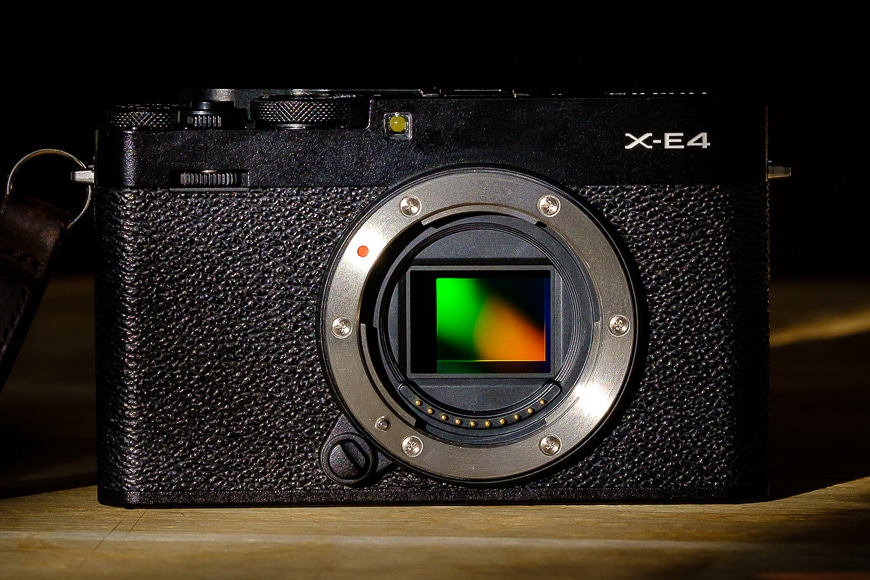
When discussing which camera sensor size is best, be prepared for a hotly contested debate…
One of the biggest challenges facing photographers today is agreeing on which sensor is best. Of course, there’s no one sensor to rule them all – this is not Lord of the Rings!
The best image sensor size depends on the intended use of the camera. Here’s a quick breakdown of how to decide which camera sensor size is best for you:
- Full-Frame
Full-frame DSLR and mirrorless cameras are ideal for professional work such as commercial, fashion and wedding photography.
Full-frame sensors have many photosites across a larger space and are best for low light performance and achieving a higher dynamic range.
Images taken with full frame sensor cameras have a lot of image detail that can be printed or displayed on a large scale without image resolution loss.
Due to the larger sensor format, full-frame cameras have a greater depth of field to achieve stunning bokeh and subject separation.
In addition, you can crop these images to achieve the desired composition without losing resolution.
The main disadvantages of full-frame cameras vs APS-C are the cost, weight and size of the camera bodies.
- APS-C (aka ‘Crop’ sensor)
The smaller size of the APS-C CMOS sensors means the camera body is also smaller than a full-frame option. It also results in lower cost while still delivering superb image and video quality.
The crop factor of APS-C is a great advantage when using telephoto lenses. A 400mm lens on a full-frame body has a 400mm focal range. But a 400mm lens on an APS-C camera with a 1.5x crop factor becomes a 600mm equivalent lens.
However, APS-C sensors are smaller with fewer megapixels, meaning they’re not as good as full-frame when shooting in low light (where you’d typically need to use higher ISO values) – for the best cameras for dark conditions, see this guide.
What’s more, APS-C cameras don’t achieve the quality of bokeh or background blur as seen with full-frame.
- Micro Four Thirds
As the name relates to the 4:3 ratio, the MFT sensor size is smaller than APS-C, but are still well suited to cinematic quality video recording.
Plus, the 2.0x crop factor means that telephoto lenses achieve even greater focal ranges – 400mm becomes an 800mm equivalent.
Finally, much like APS-C, Micro Four Thirds system cameras are generally lower in cost – although some of the pro-level video-centric MFT models are pricey.
The most significant downsides of a MicroFour Thirds sensor is the poor performance in low light conditions. The size of the sensor means fewer photosites – resulting in less light captured by the sensor.
Also, the 4:3 image ratio is not popular with some photographers, who are more used to 3:2 format images.
- Medium Format
In this case, bigger is better as medium format image sensors capture an insane amount of light and detail to produce super-high-resolution image files.
If you want to print a photo for a billboard, you should shoot with a 102MP medium format camera – there’s almost no limit on the image size.
Medium format sensor cameras are best suited to photographers at the top of their game for fashion, portrait and commercial photography – the kind of people who have clients with high demands!
The disadvantages of a medium format sensor relate more to the camera size than the sensor.
The body must be large to house a medium format sensor – larger and heavier than a full-frame DSLR.
A bigger body, bigger sensor and bigger processor equate to a higher cost – sometimes 2-3 times the price of a full-frame mirrorless camera.
Also, the power consumption of medium format bodies with larger sensors like this is considerable.
Finally, you’ll need optimal system requirements and memory on your computer to manage and edit these whopping images – editing apps such as Lightroom and Photoshop can crawl to a halt unless you have a powerful computer.
- 1-Inch
Having covered the big-guns of sensor technology, the next question to ask is, “Is a 1-inch sensor any good?”
The answer is a big yes as these smaller sensors are lighter and cheaper to make.
A 1-inch sensor features in a wide range of point and shoot cameras ideal for holiday and everyday photography.
Smartphone technology incorporates a variety of 1-inch sensors, and while these sensors are not ideal for low-light conditions, they produce a suitable resolution for use on social media platforms.
One thing to remember – the latest smartphones make use of computational photography (see guide) to make the most of their diminished sensor sizes. It’ll be some years before cameras can do this.
Which mobile camera sensor is best?
Current-generation smartphones have ever-improving technology that’s closing the gap with digital technology.
The cameras are getting better because the image sensors and processors are getting better, which is a big part of why smartphones are so expensive.
The most popular smartphones use a variant of the 1-inch sensor range to keep size and weight to a minimum. Here’s a list of the most popular handsets available and their sensor sizes:
iPhone 12 Pro Max
- Primary: 12MP 1/1.36″ sensor
- Ultra-wide: 12 MP 1/1.36″ sensor
- Telephoto: 10 MP 1/3.4″ sensor
Samsung Galaxy S21 Ultra 5G
- Primary: 108MP 1/1.33″ sensor
- Ultra-wide: 12MP 1/2.55″ sensor
- Telephoto 1: 10MP 1/3.24″ sensor
- Telephoto 2: 10MP 1/3.24″ sensor
Google Pixel 5
- Primary: 12.2MP 1/2.55″ sensor
- Ultra-wide: 16MP 1/3.09″ sensor
Camera Sensor Cleaning & Maintenance FAQs

There’s a lot of confusion surrounding the general upkeep of sensors, whether full-frame, micro four thirds or any other camera sensor sizes.
Here’s a summary of answers to the most frequently asked questions about the humble camera sensor.
How long do camera sensors last? Do camera sensors wear out?
Like any tech device, digital camera sensors will eventually wear out as the individual photosites age and cease to function. Depending on the sensor’s quality, it can last between 10,000 actions (shots) up to 300,000 and more.
It also depends on how well you look after your sensor.
How often should I clean my camera sensor?
The simple answer is never – provided you keep a lens or body cap on the camera when it’s not in use. The image sensor is incredibly sensitive, and the slight mark, smudge or speck of dust can ruin an image.
I’d recommend getting your camera sensor cleaned professionally once a year. As for how to clean your camera lens, read this article.
How do I know if my camera sensor needs cleaning?
You’ll know that your camera sensor needs cleaning if you can see dust or smudges on the sensor. Also, if you notice marks and soft spots on your photos, it’s a sign there’s dust on the sensor, and it needs a clean.
How do I know if my camera sensor is damaged?
The camera sensor is damaged if there is no sign of spots or marks on the sensor, but you’re still getting images with defects on them.
Also, you may notice that your images have what’s referred to as ‘dead pixels’. These are photosites that have stopped working and usually leave a random white pixel on your image.
If in doubt, have the sensor professionally cleaned and checked.
How do you test a DSLR sensor?
- To test your DSLR sensor, point your camera at a blue sky with the lens set to a narrow aperture.
- With the lens focused to infinity, take a few photos of the blue sky.
- Either using the rear LCD screen or your computer, check every part of the image for spots as these are signs of particles on the sensor.
- If you see spots or streaks in the image, the sensor must be cleaned.
How do you clean a mirrorless camera sensor?
- Cleaning a mirrorless camera sensor requires a delicate hand and should be approached with caution.
- If you scratch the sensor – it’s scratched for life.
- Using a special non-abrasive cleaning swab, or lens-tissue with a drop of lens cleaning solution, gently wipe the sensor from left to right.
- Repeat until all signs of dust and streaks vanish.
- A word of warning, only do this if you have experience – you can make a dirty sensor worse trying to clean it.
Which camera sensor is best?
The short answer is it depends. Sensor size mostly depends on your budget as well as the kinds of photography you do. For serious professional work, go with Full-frame. But if you are still pretty new and still learning the ropes, go with a Micro Four Thirds or even a 1-inch sensor.
Final Words
A camera image sensor is the equivalent of the human eye. It reads the available light, detail, contrast, and colour and sends the information to the processor – the human brain’s equivalent.
The sensor allows a camera to turn all of that information into stunning images and precious memories, so clearly it requires some serious thought before making a decision on your next camera purchase!
I hope this guide helped you out.
What are your thoughts on the types of camera sensors available? Do you have a preference for the sensor size you prefer when shooting with a new camera?
Join the conversation by leaving comments and questions below. Happy shooting.

Check out these 8 essential tools to help you succeed as a professional photographer.
Includes limited-time discounts.





